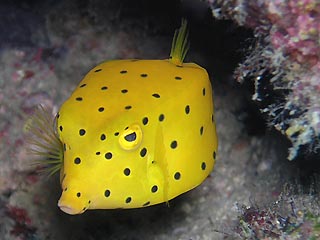Boxfish belong to the Ostraciidae family, and are often referred to as Trunkfish or Cowfish. Most of these fish are members of the genera Ostracion, Lactoria, or Tetrasomus. Boxfish reach an average size of three inches in an aquarium, while in the wild, they can grow to over 19 inches in length. Boxfish are closely related to both Puffers and Filefish. In most cases male Boxfish are larger and more colorful than their female counterpart.
Boxfish are easily recognized by their distinctive square or boxlike shapes. Their sides are actually bony plates covered by a thin skin. This becomes important if there are so-called cleaner fish in your tank, as the Cowfish's delicate skin may not tolerate this behavior. Two pairs of bony horns distinguish the Cowfish — one on the head and one just above the caudal fin. The horn-like protrusions from the head and above the caudal fin serve to deter predators. Some Boxfish have the ability to release a toxin called ostracitoxin, which is used to ward off predators. It is important to note that if this toxin is released into the aquarium, all the tank inhabitants can be killed, although this does not occur often.
Only the fins of the Cowfish are moveable, which they use to slowly propel themselves through the water. Since they have poorer locomotion, it is necessary to carefully monitor their eating habits, since more aggressive tank mates may prevent them from reaching the food. Cowfish are omnivorous bottom feeders, consuming both algae and crustaceans and sampling polyps on occasion.
Boxfish are found throughout the world, and are most commonly associated with coral reefs. They can also be found near rocky areas, sand flats or grass beds. Most of these fish are found in harems of one male and several females. The breeding of these fish in an aquarium is extremely difficult.
It is imperative to maintain Boxfish with peaceful tank mates as they are often easy targets for more aggressive fish. If more than one Boxfish is to be kept in the aquarium, it is advisable to introduce similar sized fish to the aquarium simultaneously.
They are generally compatible with: Dwarf Angelfish, Large Angelfish, Anglers & Frogfish, Anthias, Basslets, Batfish, Blennies, Butterflyfish, Cardinalfish, Clownfish, Damselfish, Eels, Filefish, Goatfish, Gobies, Grunts & Sweetlips, Hawkfish, Hogfish, Lionfish & Scorpionfish, Parrotfish, Pseudochromis, Squirrelfish, Tangs & Surgeons and Wrasse.
Caution is required with: Boxfish, Groupers, Puffers and Triggerfish.
They are not compatible with: Seahorses & Pipefish and Sharks & Rays.

No comments:
Post a Comment